GRE Math Practice Test II
"The Adaptive Test"
P. 2 (Problems 10 - 19)
WTAMU > Virtual Math Lab > GRE Math
 Introduction Introduction
Because of the enormity of this
part, I split the adaptive test into three pages. P. 1 has the questions to all
levels of the first 9 problems. This page, P.
2, has the questions to all levels of problems 10 -
19. P.
3 has the questions to all levels of problems 20 -
28.
If you
are looking at this page before P. 1, then you need to go to P. 1
of the adaptive test to start this adaptive test.
Printing
warning:
Note that because of all of the levels per problem, there are a lot of
questions on this page. So if you wish to print this out, note
that there
will be a lot of pages to print.
|
 Practice Test II, Problems 10 - 19 Practice Test II, Problems 10 - 19
Column A
 |
Column B
6 |
A) Column A’s quantity is
greater.
B)
Column B’s quantity is greater.
C)
The quantities are the same.
D)
The relationship cannot be determined
from the information given.
|
Column A
 |
Column B
 |
A) Column A’s quantity is
greater.
B)
Column B’s quantity is greater.
C)
The quantities are the same.
D)
The relationship cannot be determined
from the information given.
|
Column A
 |
Column B
 |
A) Column A’s quantity is
greater.
B)
Column B’s quantity is greater.
C)
The quantities are the same.
D)
The relationship cannot be determined
from the information given.
|
Column A
 |
Column B
 |
A) Column A’s quantity is
greater.
B)
Column B’s quantity is greater.
C)
The quantities are the same.
D)
The relationship cannot be determined
from the information given.
|
Column A
 |
Column B
 |
A) Column A’s quantity is
greater.
B)
Column B’s quantity is greater.
C)
The quantities are the same.
D)
The relationship cannot be determined
from the information given.
|
11 - 1.
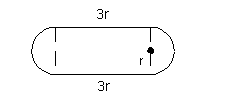
If the radius of the equal semicircles is r
and the length of the rectangle is 3 r,
which of these expressions represents the perimeter of this object? |
11 - 2.
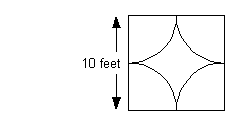
Using the figure shown, find the area of the middle region inside the
square. |
11 - 3.
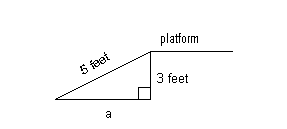
A ramp 5 feet long is leaning against a raised platform which
is 3 feet above the ground. What is the distance from the ramp’s contact point
with the ground and the base of the platform?
|
|
B)
4
C) 5
D)
2
E) Not enough
information to answer this question.
|
11 - 4.
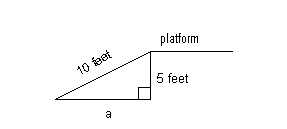
A ramp 10 feet long is leaning against a raised platform which
is 5 feet above the ground. What is the distance from the ramp’s contact
point with the ground and the base of the platform?
|
|
B)
125
C) 
D) 
E) Not enough
information to
answer this question.
|
11 - 5.

What is the area of the rectangle above?
|
|
B) 
C) 
D)
35
E) Not enough
information to
answer this question.
|
12 - 1.
 = =
|
12 - 2.
 = =
|
12 - 3.
 = =
|
12 - 4.
 =
=
|
12 - 5.
 =
=
|
13 - 1.

|
13 - 2.

|
13 - 3.

|
13 - 4.

|
13 - 5.

|
14 - 1. A student got 80% of 40 questions
correct.
How many questions did he get correct? |
14 - 2. Quiz scores on a history exam are
9, 9,
7, 10, and 5. If there is one more quiz, what would need to be
made
on that quiz to have an overall average of 7? |
14 - 3. A student has quiz scores of 70,
75 and 55. If tests count as 2 quiz grades, what would he have to make
on a test, so that the overall average is 70? |
14 - 4. If 30 students in one class had
an average of 80% and 10 students from another class had another average of 90%,
what is the average in % of all 40 students? |
14 - 5. If 5 students in one class had an
average of 55%, if 15 students in one class had an average of 80% and 7
students from another class had another average of 92%, approximately, what is
the average in % of all 27 students? |
15 - 1.  and  |
Column A
 |
Column B
 |
A) Column A’s quantity is
greater.
B)
Column B’s quantity is greater.
C)
The quantities are the same.
D)
The relationship cannot be determined
from the information given.
|
15 - 2.  and  |
A) Column A’s quantity is
greater.
B)
Column B’s quantity is greater.
C)
The quantities are the same.
D)
The relationship cannot be determined
from the information given.
|
15 - 3.  and  |
A) Column A’s quantity is
greater.
B)
Column B’s quantity is greater.
C)
The quantities are the same.
D)
The relationship cannot be determined
from the information given.
|
15 - 4.  |
Column A
 |
Column B
9 |
A) Column A’s quantity is
greater.
B)
Column B’s quantity is greater.
C)
The quantities are the same.
D)
The relationship cannot be determined
from the information given.
|
15 - 5.  |
Column A
 |
Column B
8 |
A) Column A’s quantity is
greater.
B)
Column B’s quantity is greater.
C)
The quantities are the same.
D)
The relationship cannot be determined
from the information given.
|
16 - 1.
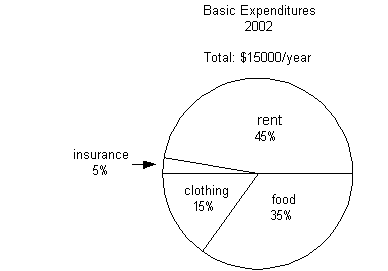
How much was spent on rent in 2002?
|
16 - 2.

What was the total amount spent on food and clothing in 2002?
|
16 - 3.

How much more money was spent on clothing than insurance in
2002?
|
16 - 4.

How much more was spent on rent and insurance than on food in
2002?
|
16 - 5.

If the amount that was spent on food is 5% higher in 2002 than
2001,
approximately what amount was on food in 2001?
|
17 - 1.
 |
Column A
The ratio of food to clothing. |
Column B
The ratio of clothing to food. |
A) Column A’s quantity is
greater.
B)
Column B’s quantity is greater.
C)
The quantities are the same.
D)
The relationship cannot be determined
from the information given.
|
17 - 2.
 |
Column A
The ratio of food to rent. |
Column B
The ratio of rent to food. |
A) Column A’s quantity is
greater.
B)
Column B’s quantity is greater.
C)
The quantities are the same.
D)
The relationship cannot be determined
from the information given.
|
17 - 3.
 |
Column A
The ratio of food to insurance. |
Column B
The ratio of insurance to food. |
A) Column A’s quantity is
greater.
B)
Column B’s quantity is greater.
C)
The quantities are the same.
D)
The relationship cannot be determined
from the information given.
|
17 - 4.
 |
Column A
The ratio of insurance and rent to food and clothing. |
Column B
The ratio of food and clothing to insurance and rent. |
A) Column A’s quantity is
greater.
B)
Column B’s quantity is greater.
C)
The quantities are the same.
D)
The relationship cannot be determined
from the information given.
|
17 - 5.
 |
Column A
The ratio of food and insurance to clothing and rent. |
Column B
The ratio to clothing and rent to food an insurance. |
A) Column A’s quantity is
greater.
B)
Column B’s quantity is greater.
C)
The quantities are the same.
D)
The relationship cannot be determined
from
the information given.
|
18 - 1.
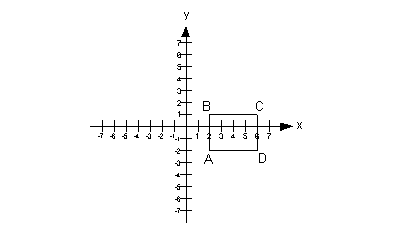
Find the area of rectangle ABCD shown above.
|
18 - 2.
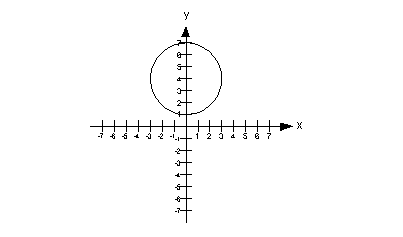
Find the area of the circle shown above.
|
18 - 3.
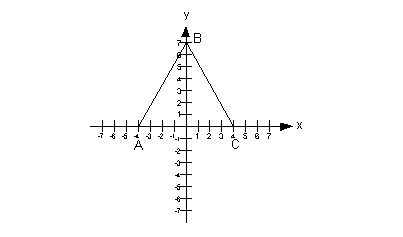
Find the area of triangle ABC shown above.
|
18 - 4.
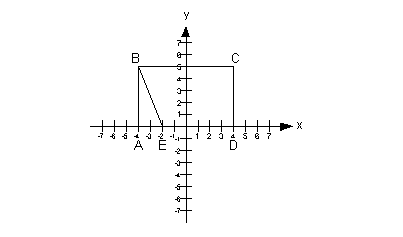
Find the area enclosed by BCDE shown above.
|
18 - 5.
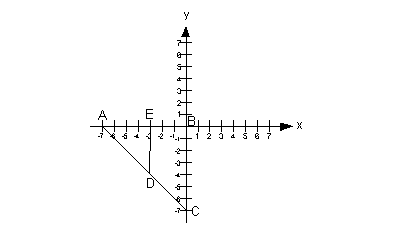
Find the area enclosed by BCDE shown above.
|
19 - 1. What is the solution(s) to 
? |
|
B)
3, -3
C)
0
D)
81, -81
E)
No real number solution
|
19 - 2. What is the solution(s) to 
? |
|
B)
49, - 49
C)
98, -98
D)
7, -7
E)
No real number solution
|
19 - 3. What is the solution(s) to 
? |
|
B)
2, -2
C)
D)
4, 9
E)
No real number solution
|
19 - 4. What is the solution(s) to 
? |
19 - 5. What is the solution(s) to 
? |
|
B)

C)
5, -5
D)

E)
No real number solution
|

Disclaimer:
Note that we can not
guarantee that you will pass your test after going through any of the tutorials in this website. However, it will definitely help you to
better understand the topics covered. WTAMU and Kim Seward are not
responsible for how a student does on any test for any reason including not being
able to access the website due to any technology problems.
GRE and Graduate Record Examination are the
registered trademarks of Educational Testing Service (ETS). The material here has
neither been reviewed nor endorsed by ETS.
Throughout this website, we link to various
outside sources.
WTAMU and Kim Seward do not have any ownership to any of these outside
websites and cannot give you permission to make any kind of copies of
anything
found at any of these websites that we link to. It is purely for
you to link to for information or fun as you go through the study
session.
Each of these websites have a copy right clause that you need to read
carefully
if you are wanting to do anything other than go to the website and read
it. We discourage any illegal use of the webpages found at these
sites.
|
All contents copyright (C) 2003 - 2008, WTAMU and Kim Seward. All rights reserved.
Last revised on September 15, 2008 by Kim Seward. |
|
|


